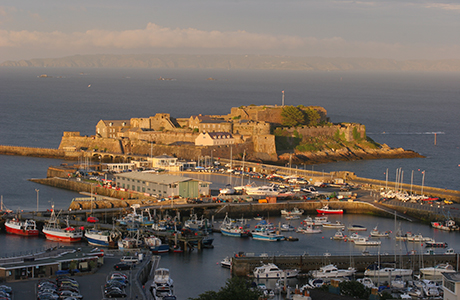It all started in 1922, when captive legislation was first initiated in Guernsey to support an insurance industry that had been active since the 18th century. Though it may have taken more than 50 years to get up and running, the industry on the island has benefited from its years in the game.
It all started in 1922, when captive legislation was first initiated in Guernsey to support an insurance industry that had been active since the 18th century. Though it may have taken more than 50 years to get up and running, the industry on the island has benefited from its years in the game.
Codes of conduct covering captive insurance companies are included in the Insurance Business (Bailiwick of Guernsey) Law 2002, and the Protected Cell Companies Ordinance 1997 as amended by the Protected Cell Companies (Amendment) Ordinance 1998. Major growth areas include ATE insurance, credit insurance, professional indemnity reinsurance and transformer cell, with the island housing companies such as Aon, Barbican, Catlin, Chartis, Generali, Hiscox, Jardine Lloyd Thompson, Marsh, Old Mutual, Royal & SunAlliance, SCOR and Willis.
“Guernsey has a combination of many of the key attributes for a successful captive domiciles,” says Chris Le Conte, CEO of Robus Group. “It has a strong and competitive industry of insurance managers with a mix between the major brokers and independents; an approachable and knowledgeable regulator and flexible regulation; an experienced suite of advisors from the legal, banking, investment and accounting professions; geographical proximity to London and good communication links; a 0 percent corporate tax rate; andfinally, Guernsey brings that added value of innovation.
“We have had protected cell companies (PCCs) of course, then incorporated cell companies (ICCs), and now the new risk purpose trust, which has applications to captive insurance. When you put all of these together, it is no surprise that Guernsey continues to thrive as a domicile for those operating or interested in operating captive structures.”
Fiona Le Poidevin, chief executive of Guernsey Finance, adds that growth is better than expected for the current climate, with a 53 percent rise in the number of new licences since the end of 2011, bringing the island up to to 687 insurance entities, including PCC cells, as well as standard subsidiary captives.
“We’re now standing, as of the end of August, at 741 entities: a huge increase of 54 insurance entities and a statistic we’re very pleased with. A lot of that growth has come from one particular structure, JLT group in Guernsey, which is assisting the UK government with the NewBuy scheme. This is where first-time buyers can get a mortgage of 95 percent, which effectively is underwritten by government, and then reinsured back to the captive.”
“There are around 46 cells now in that structure, and it is growing rapidly. We’ve also seen Nomura setting up a captive, which has been the catalyst for lots of new business coming in, and as I understand from regulators, there are more things in the pipeline and they are seeing a lot of new applications at the moment. It is all very positive.”
The NewBuy scheme is indicative of Guernsey’s ability to cater for a niche. Le Poidevin says: “As we’re a small jurisdiction, we’re quite nimble in terms of being able to move fast and react to things. If you look at innovative matters, PCCs were pioneered in Guernsey in 1997, and that really gave us another market leading capability. We havethe most experience in PCCs, and now we can offer ICCs as well, which have different uses, as well as other new innovations. People are always working on new things, in what is essentially a mature market.”
As for the effects of Guernsey’s geographical proximity to—and political separation from—Europe: “As far as our economic situation is concerned, we’re not part of the EU and we’re not part of the UK, so we are not required to follow EU directives,” says Le Poidevin. “Geographically, we’re centrally in Europe, so are quite well placed. In terms of time zones, we can do business with the Americas and Asia in the same day, which is a benefit that people like.”
Though the island’s location and time zone are not as convenient as the likes of Singapore, Le Poidevin is hopeful of more captive work coming from the Far East.
“In China, there’s so much wealth that a lot of businesses are expanding out into Europe, and in time they may wish to have a captive for their European operations,” she says. “Guernsey’s position means that we’re ideally placed, so if you are going to come to Europe to look for captive insurance, logically you would come to Guernsey.”
The island may also be well-placed for to offer Asian and Latin American-owned captives, due to its depth of knowledge.“We do see opportunities in both Asia and Latin America,” states LePoidevin. “As businesses become more sophisticated and more international, they will start understanding the reasons why you would use a captive as opposed to third-party insurers in the market. Also, we have an initiative for cleantech and renewable energy, and it’s the emerging markets that are really investing in that because they have such great energy demands. Given the growth that’s happening in those countries, technologies will develop quite rapidly, and you’ll then see a need for more insurance products. I think that captives could definitely play a part in that in the future.”
No, no, no
Diane Colton, the Guernsey Financial Services Commission’s (GSFC’s) former director of insurance, wrote in December 2009: “Guernsey is well positioned to benefit from the introduction of the Solvency II regime in Europe, provided it can achieve equivalent status under the directive. This will benefit both the captive insurance and the reinsurance sectors.”
But the GFSC’s stance changed, due in part to discussions with the Guernsey International Insurance Association (GIIA), and for the last two years, the island has said that it will not seek Solvency II equivalence.
“The government and the regulator made the decision back at the beginning of 2011. Obviously there’s still a lot of uncertainty around the directive and the timing, so at the moment, it’s just a case of watch this space from a Guernsey perspective,” states Le Poividen.
“We made a definite decision not to seek equivalence because the directive was really there to address systemic risks in the system and protect the policy holder. Therefore, it just doesn’t suit the captive model. There’s been a lot of research done to say that a significant number of captives would be technically insolvent under Solvency II, and yet most of our captives are incredibly well capitalised and well over the minimum regulatory levels that we have and that we follow through the IAIS core principles.”
“It is all about being proportional, and at the moment, Solvency II doesn’t give that proportionality and flexibility. It is very difficult to do that, as the directive has to cater for the whole insurance market, so until there’s a workable solution we will continue to be outside of Solvency II. I think that making that definite decision in 2011 gave us certainty for our clients. There’s no sitting on the fence, and I think that’s attributed to some of the growth we’ve seen over the last year and a half.”
While the door is shut is on Solvency II in Guernsey, the island is yet to lock the door and throw away the key.
Le Conte says: “In my view, the jury remains out in the medium term. Like Bermuda, the ideal scenario would have been for Guernsey to seek to have a class of insurers classified as Solvency II equivalent and another class classified as not. The trouble was that we could not get clarity from Europe as to whether that would be possible and therefore Guernsey took the ‘safe’ path of protecting existing business as much as possible from a regulatory system that was broadly irrelevant. This was the correct decision, but if Bermuda does end up with a successful bifurcated system, Guernsey should re-open that debate.”





